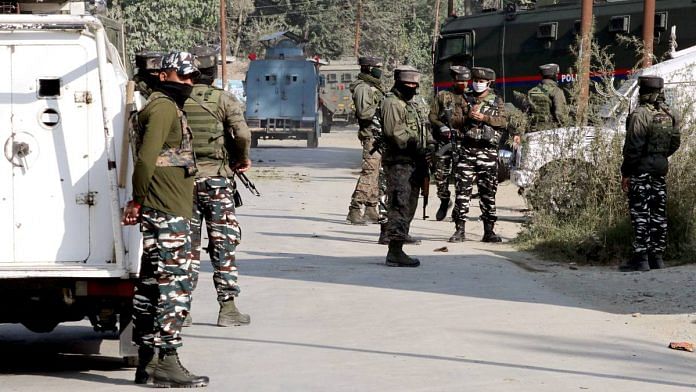Srinagar: The year 2020 saw a significant spike in local recruitment in militant ranks in Kashmir, which security officials said could be a result of the “backlog” triggered by the communication blackout in Jammu and Kashmir due to the scrapping of Article 370 in 2019.
According to police data, accessed by ThePrint, last year saw the second-highest recruitment of Kashmiri youth in the past decade, with Pulwama topping the list of places from where maximum youths have joined insurgent outfits. The year 2018 saw the highest number.
Former security establishment officials said the rise in recruitment was also due to ‘Pakistan’s project’ and a sense of alienation among the youth.
The data showed that 167 youths from Kashmir joined militant groups last year. It also stated that 225 militants — 203 from Kashmir — were killed across Jammu and Kashmir in 2020.
As many as 50 youths from Pulwama — where the deadly suicide bombing had taken place in February 2019 — joined militant groups last year, followed by Shopian (41) and Kulgam (30).
The data also showed that even as southern Kashmir continues to be a hotbed of militancy, insurgent groups have been able to make inroads across the Valley, with militant recruitment reported from districts like Budgam, Baramulla and Srinagar too.
Security establishment officials expect an escalation of law and order situation in the wake of rising militant recruitment even after the killings of Hizbul Mujahideen commanders Riyaz Naikoo and Saifullah Mir last year.
Also read: Terror recruitment in Kashmir ‘very high’, Al Badr active again as Pakistan revives outfit
The numbers
The number of youth joining militant groups in 2018 stood at 199 — highest in the last decade — and in 2019, the number was 126, according to the police data.
The recruitment figure between 2014-2017 stood at 53, 66, 88 and 139, respectively.
“Last year, 225 militants were killed across J&K in 103 gun battles. Around 50 militants were arrested. Another 625 over-ground workers who provided logistics to militants were arrested as well. No doubt recruitment of locals in 2020 is a major concern, but we are taking all the precautions,” said a senior police officer, requesting anonymity.
“We expect Pakistan-backed groups to escalate violence across Kashmir as well as Jammu region,” the officer added.
Security officials also believed that the increase in militant recruitment is due to a “backlog” arising from the communication blackout that was enforced ahead of the scrapping of Article 370 in August 2019.
“The recruitment number has to be seen in context of the communication blackout during which the numbers were low. The locals, who could not join militancy in 2019, did so last year,” a source said.
Security officials further said that recruitment in districts such as Baramulla, Budgam and Srinagar is worrisome.
A total of 15 youth from Baramulla, five each from Budgam and Srinagar joined militant groups in 2020. Militant outfits also recruited youths from Ganderbal, Bandipora and Kupwara, police data showed.
‘Pakistan’s project to show militancy as local resistance’
Senior security officials believed that the rise and spread of insurgency are a part of a larger reaction of militant groups to the constitutional changes ushered in J&K in 2019.
Former J&K DGP S.P. Vaid said, “Pakistan has taken up a project to show militancy as local resistance, which is not the case. During my time, youths were being instigated via social media to join militancy.”
The police data showed that Hizbul Mujahideen, which primarily comprises local Kashmiri militants, recruited 68 youths in 2020.
According to the data, of the 167 youths who joined militant ranks last year, 43 are believed to have joined the Lashkar-e-Taiba (LeT) and its offshoot The Resistance Front (TRF).
Another 22 youths have been listed to have joined Jaish-e-Mohammad (JeM).
“Both Lashkar and JeM have increasingly taken in Kashmiri recruits, though their decision-making powers continue to lie with the foreign commanders,” said a senior police official posted in south Kashmir.
The data also showed that the pro-Pakistani Al Badr militant outfit recruited 24 youths in 2020. Outfits that are not staunchly pro-Pakistan, such as Ansar Ghazwat-ul-Hind, formed by former Hizbul commander Zakir Musa, recruited four youths, while Islamic State J&K recruited only one youth last year.
Vaid said that while instigation by Pakistan is a major factor, a sense of alienation continues to exist in some sections in J&K.
“Even during my time, people would complain that their kids are tortured and that it was better to become a militant. There was a sense of alienation towards how the local police and forces handle the situation. God knows how true is that but the alienation exists and needs to be removed,” said Vaid.
However, Ajai Sahni, executive director of Delhi-based security think-tank Institute for Conflict Management, said the rising recruitment numbers were not significant as the figure is bare minimum to sustain what he called “residual militancy”.
“Jaish, Lashkar or this new outfit TRF, no group matters. It is the ISI which decides which group to project more, when to shift cadres of one outfit to another and so on. Right now, there is a lot of attention on prominent militant groups, so you see the rise of TRF or Al Badr,” said Sahni.
Also read: In Kashmir, militants are high on recruitment, but weaponless



